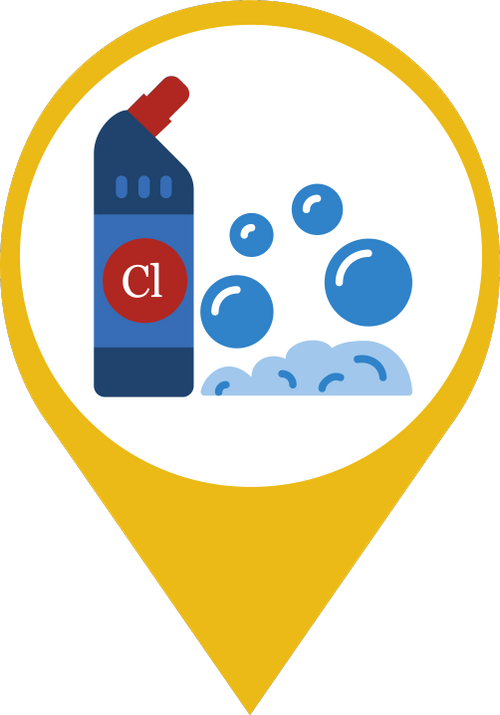Disinfection By-products
Disinfection By-products
Also known as chlorination by-products, trihalomethanes, DBPs. 
What are they?
Disinfection by-products (DBPs) are specific molecules that form when a chemical is used to disinfect water for drinking or for release into the environment. The disinfecting chemical reacts with naturally occurring organic matter in the raw water.
Chlorine is the most commonly used disinfectant in the world (and possibly also the greatest public health achievement of the 20th century). However, using chlorine as a disinfectant produces trihalomethanes, including chloroform and bromoform.
Other examples of DBPs from disinfection include:
- DBPs resulting from chlorine dioxide disinfection: chlorate, chlorite.
- DBPs resulting from ozone disinfection: bromate, formaldehyde.
- DBPs resulting from chloramine disinfection: N-nitrosodimethylamine (NDMA).
Are DBPs regulated in Alberta?
Yes, the most frequently detected DBPs are regulated with specific detection limits for the individual compounds and the total for the group. For example, the total allowable quantity of trihalomethanes is 100 parts per billion, but each trihalomethane has a specific limit as well.
Are disinfection by-products in my water?
Source water
No, there is no evidence of disinfection by-products present before the water has gone through the disinfection process.
Tap Water
Yes, there are DBPs in tap water. The amount and type of DBPs depends on what trace substances are in the source water and what process is used for disinfection.
Many technologies exist to help limit DBP formation and remove DBPs from tap water. These are often employed at treatment plants, which have a higher likelihood of producing DBPs. The Guidelines for Canadian Drinking Water have thresholds for DBPs, requiring water service providers to monitor for their presence and ensure they remain below certain thresholds.
What are the impacts on human health?
People are exposed to DBPs through drinking water, showering, and swimming in chlorinated swimming pools.
When people are exposed to high concentrations, many of the chemicals that are formed as DBPs have been shown to have serious human health effects. Trihalomethanes are considered carcinogens, suspected of causing kidney and liver cancer. However, it is very rare for high concentrations to be found in water. An example for reference is that NDMA is found in much higher concentrations in bacon and beer than is detected in drinking water.
What are the impacts on the environment?
DBPs do not generally have a significant impact on the environment because they are formed from disinfection of drinking water. This means the DBPs have usually evaporated or degraded by the time the wastewater is released back to the environment.
How do disinfection by-products get into the water?
DBPs are formed in the water when disinfection substances react with natural organic matter and other chemicals. DBPs themselves are not added to water but they form, under specific circumstances, when certain chemicals are added to water.
What can we do about disinfection by-products in the water?
DBPs cannot be avoided as they are a part of the disinfecting process.
Water treatment professionals are trained in practices and processes that help limit the production of DBPs.
Where can I find more information?
Disinfection by-products information from the centre for Disease Control
Chlorination by-products in Canada, general information
Guidelines for Canadian Drinking Water
Sources:
Charrois, J., Graham, D., Hrudey, S. and Froese, K. (2004). Disinfection By-products in Small Alberta Community Drinking-water Supplies. Journal of Toxicology and Environmental Health, Part A, 67(20-22), pp.1797-1803. https://www.ncbi.nlm.nih.gov/pubmed/15371217
Hrudey, S. (2004). Chlroination Disinfection By-products (DBPs) in Drinking Water and Public Health in Canada, a primer for public health practitioners reviewing evidence from obver 30 years. http://www.ncceh.ca/sites/default/files/Chlorination_Disinfection_By-Products_2008.pdf
World Health Organization (2005). Trihalomethanes in Drinking-water: background document for development of WHP guidelines for drinking-water quality. http://www.who.int/water_sanitation_health/dwq/chemicals/THM200605.pdf
Government of Canada (2013). Guidelines for Canadian Drinking Water Quality: Guideline Technical Document – Trihalomethanes. https://www.canada.ca/en/health-canada/services/publications/healthy-living/guidelines-canadian-drinking-water-quality-trihalomethanes/page-3-guidelines-canadian-drinking-water-quality-trihalomethanes.html#guidelines
